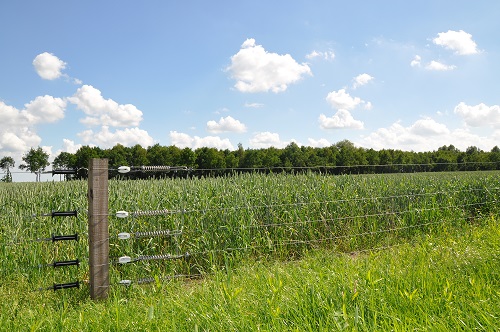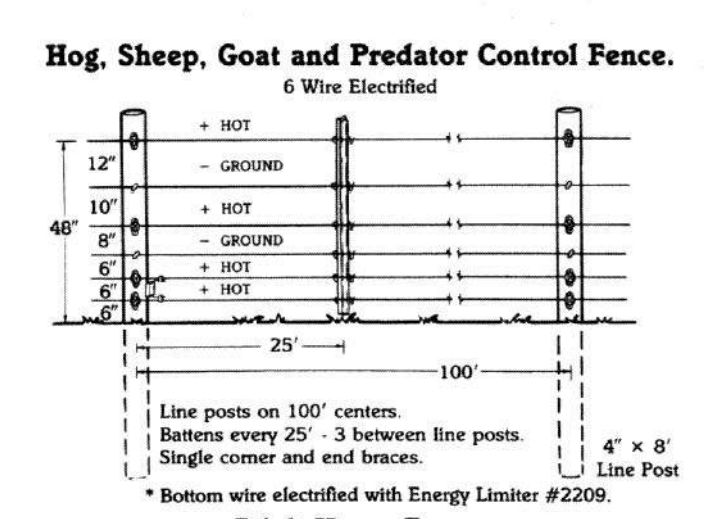Below is actually how I write my notes for a project. At different points I may delete stuff or add new stuff in the middle. I also don’t use proper sentences all the time as some thing are thoughts I stick in there when they come to me. At the bottom of the page is a link to an update, some of which will also be notes to start. When the fence is done, I’ll come back and make a proper article with plenty of pics and tips. Due to the rockiness of the soil on over half the property and cost, I decided to go with High-Tensile Fence. They cost less than other fence types and take way less posts as they can be spaced out up to 100 foot. I think I’ve got a couple level spots that long. You need a major post or two or three posts with braces, at every peak and valley. Anywhere the fence wire would hit the ground or be up off the ground too much, you need posts to take care of it but many can be small like a t-post or a 3 1/2 inch wood post with a point on one end that gets driven in. Dare Products makes fence systems and has a Fence Designer, which is basically a parts calculator, that is handy. They also have a few pdfs for download, including one for High-Tensile Fence installation. https://www.dareproducts.com/pdf/high_tensile_fence_system.pdf That link comes from their fence designer page which you’ll find in the main menu on their site. https://www.dareproducts.com 6 strands of smooth wire on wooden posts stretched to high tension which allows post spacing of 80-100 feet
Will be closer to 60 foot apart on average, ranging anywhere from 20-100 feet, due to terrain. “*Bottom wire electrified with Energy Limiter #2209” That would be this thing(I had a hard time finding one of these and the insulation breaks instead of being flexible which tells me it sat around for a long time, possibly in a hot warehouse)
“If your fence’s lowest run of wire or polyconductor is likely to contact weeds, brush, or other objects that will drain away the fence’s charge, consider using this power drain limiter. It can keep power on the fence’s other runs by limiting the amount of charge allowed to flow onto the lowest run. Install one power drain limiter at every point where power is fed into the lowest run. Product 06-14 (Dare).” It keeps the bottom wire from draining the system and keeps the other energized wires hot. The majority of this fence is going through the woods and going across a few small ravines that become wet weather creeks during heavy rains. With the bottom wire at 6 inches, leaves could pile up against it. I might try the bottom wire at 8 inches up instead. We’ll have a kidding area and then after they’re a few weeks old, power up a fenced in area to train them in and when they’re trained to the fence and big enough, let them loose on the property. Fence will have approx a 3250 foot perimeter (2180 for just part of the 8 acres done by itself) 
This is an old survey from the 80s when they split a piece into 8 pieces approx 8 acres each. I miraculously found it online before we had signed the contract. There’s a little dotted/dashed line just below the North line which represents an old fence. There was a recent survey done on the 7.5 acres and a few years ago, a survey on the 9 acres that’s partly showing on the right. Both of them were done by the company that does the County’s surveys and evidently the survey done in the 80s was off by 40-45 feet on that North line and not in my favor. With the North line of the 8 acres being 1175 feet long, 40×1175=47,000 sq ft or just over 1 acre loss. (must be that +- thing) 13,760 loss on the 7.5 acres for a total of 60,760 sq ft for both which is 1.39 acres total loss. Now I’ve heard from more than one person that an old fence line takes presedence over a newer survey. The old fence line was about 20-25 feet off and as per the old survey, not in my favor but for the new survey, in my favor so if I were to build my fence where the old fence was, I could cut my losses in half. I’ll probably just take the loss. Gate at the bottom end at the road Gate to the garden area and future house 12 posts plus 4 braces for corners
- 60 line posts 6 strand fence x 3250 perimeter = 19,500 20,000 feet of wire
- 60 posts x 4 energized strands = 240 insulated clips
- 60 posts x 2 ground strands – 180 staples
- Need to measure for garden/house/yard fence(s) Dare Energy Limiter
- Kencove Clearance items as of 12/16/18 (Check Prices against other suppliers – some “clearance” items might not be a good deal)
- Strainer (mini come-a-long) $1.95 https://kencove.com/fence/Featured+Items-Clearance_detail_U-20401.php
- Fi-Shock Multi-Groove Poly-Dropper(batten) – 49″, Black $2.95 https://kencove.com/fence/Featured+Items-Clearance_detail_U-200-260.php
- Zareba Multi-Groove Dropper Clips – Pack 25 – $2.50 https://kencove.com/fence/Miscellaneous-Clearance_detail_U-HTPSCLIP.php
- 12½ Gauge Crimp Sleeves – Pack 100 $6.95/100ct https://kencove.com/fence/Connectors-Clearance_detail_U-20415A.php
- Zareba Ground Rod Clamp $1.25 https://kencove.com/fence/Connectors-Clearance_detail_U-GRC-Z.php
- Zareba Spinning Jenny/Fence Dereeler $29.95 https://kencove.com/fence/Hardware-Clearance_detail_U-HTSJ.php
- Dare 2-Slot Fence Splicing Tool $29.75 https://kencove.com/fence/Hardware-Clearance_detail_U-2132.php
- Dare Tension Measuring Spring $3.95 https://kencove.com/fence/Hardware-Clearance_detail_U-AD-2041.php
- Zareba Wire Cutters $7.95 https://kencove.com/fence/Hardware-Clearance_detail_U-FWC1.php
- Zareba Plated Brace Pins – 10″, Pack 5 – $2.00 https://kencove.com/fence/Hardware-Clearance_detail_U-HTBP10.php
- Red Snap’r T-Post Snap-on Insulator – Yellow, Pack 25 – $5.00 https://kencove.com/fence/Insulators-Clearance_detail_U-IT2XY-RS.php
- Red Snap’r Wood Post Pin-Lock Insulator – Yellow, Pack 25 – $6.75 https://kencove.com/fence/Insulators-Clearance_detail_U-IWPLNY-RS.php
- OR Zareba Large Ceramic Lag Screw Insulator $1.00ea (for corner brace posts only) https://kencove.com/fence/Insulators-Clearance_detail_U-WP-1929.php
- OR Fi-Shock Ceramic Wood Post Insulator $0.27ea https://kencove.com/fence/Insulators-Clearance_detail_U-MP-5E.php
- Zareba Corner Post Insulators – Yellow, Pack 10 – $2.95 https://kencove.com/fence/Insulators-Clearance_detail_U-ICY-Z.php
- OR Zareba Heavy-Duty Porcelain Insulators – White, Pack 10 – $3.95 https://kencove.com/fence/Insulators-Clearance_detail_U-WP-4.php OR Fi-Shock Ceramic Wood Post Insulator $0.27ea https://kencove.com/fence/Insulators-Clearance_detail_U-MP-5E.php
- Also various fence chargers but none are dual purpose and AC/DC which is what I want.
- Zinc/Aluminum, 200 KSI, 12½ Gauge – 4,000′ Coil $99.75 – not on clearance but good price for aluminized – shipping is $150-200 plus 6 rolls @ 586.50 = $736.50 – $786.50 https://kencove.com/fence/Galfan_detail_WG2.php
- Wire $750
- Clips $100
- T-Posts $210
- Strainers $36
- Springs $72
- Brace Pins $6
- Battens $60
- Tools/misc $300
$1550 for 12.5 acres OR $1000 for 5 acres (part of 8 acres) I thought about just fencing in the area on the 8 acres and fencing the 7.5 acres later but it’s not very cost effective. Approx 5 acres of the 8 would cost $1000 while that 5 plus the 7.5 for a total of 12.5 will be $1500.00 $200/acre for the 5 and $120/acre for the 12.5 Just about twice the bang for the buck. Cross fencing doesn’t have to be as built as the perimeter so we’ll do the perimeter now and cross fencing later. Kind of a mish mash of parts listed above as I haven’t decided on what to use for line posts. 3 1/2″ treated wood posts are preferred but close to $6.00 each, plus insulators which are around a dollar per post. Fiberglass would be my preference but they’re not available locally and they’re pricey even without oversized shipping charges. I might be able to get 1 1/4″ repurposed fiberglass sucker rod from someone near Kansas City which is only a two hour drive. If I buy them at the full length of 36 feet and bring my cordless sawzall to cut them in half for trailering, I think I can get them real cheap. I have to say, after shopping for parts on the web, Kencove had the best selection and prices, especially if you hit their clearance section. The only issue I have with them is their shipping prices. Outrageous unless you can hit their Free Shipping mark of $75.00 Click here for the Fence Update




